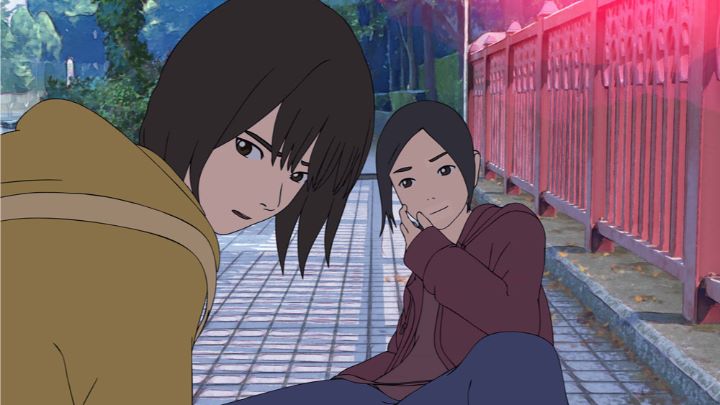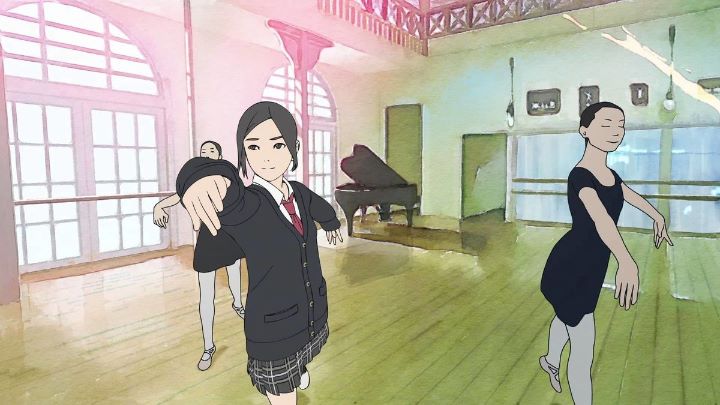






"The Case of Hana & Alice" is a hand-drawn-with-rotoscope/CGI animated film from 2015, which eventually received a home video release from GKIDS in North America in 2019. It probably had more hype and significance to a Japanese audience than it did elsewhere: it's a prequel to a 2004 live-action film called "Hana and Alice," about the two title teenage characters meeting for the first time. Knowledge of the original film isn't necessary to enjoy this new movie.It begs several questions as to why or how the film came to be: absolutely nothing in the movie makes a strong case that animation was necessary. Both the original director and original female actors return for the new movie. Perhaps they new they couldn't make a live-action film again, with the "teenage" cast now a decade older? Maybe they felt animation and anime was just more trendy, and used it as a business decision? Perhaps a producer choice animation, but the director and team underneath chose rotoscoping to challenge themselves? The Bluray comes with over an hour of interviews, so I'm certain the reason comes up somewhere in documentation.How does the animation turn out in the final movie? I have mixed feelings. As a reminder, "rotoscoping" usually refers to shooting live-action actors as reference, and drawing on top of that, as a cheaper and easier method for creating realistic-looking animation. Typically, it produces a interesting-looking result, but also rougher and less stylized and idealized than typical cartoons (on a bizarre interview inclusion, unrelated director Makoto Shinkai made a similar statement, noting how realistic and unattractive the film's characters were). The case is the same with "The Case of," looking less ideal than typical anime, but watchable purely in fascination. But more than half of the film is CGI, trying to use a similar visual style, but in these scenes, the animation itself is clearly more clunky. Not always merging well with backgrounds, some animated scenes look barely acceptable for a student film. Not to mention that Japanese acting and camera movement can seem... weak, after being used to expensive productions from America and Europe for so long. There is some merit to the experimental style. One is that CGI and hand-drawn is used interchangably. It's noticable if you look for it, but the design of flat unshaded characters with black outlines with realistic body proportions is consistent, and that persistence to a style is admirable. It genuinely confused me: technically, forms of rotoscoping could be done with computer animation in a few different ways, but I wonder if they bothered at all, or simply animated some scenes freehand. Finally, the artists took some liberties with human faces, often the weakest part of rotoscoping animation (and even more noticable with Japanese actors). In "The Case of," the faces are simplified to be a bit more cartoonish, allowing for some well-placed expressions for comedic effect, and making the overall film feel much warmer than it might otherwise. Technical talk aside, what is the story actually about? Tesuko Arigugawa (nicknamed "Alice") is a new transfer student, tomboyish and crude, with a kind but awkwardly out-going mother. Her placement in the classroom makes her the subject of bullying: the center desk belonged to "Judas," a student who was killed a couple years earlier by four other "Judas"'s, and who had since continued to haunt the school. What was the source of this ghost story? Was there any truth in it? Her search leads her to Hana Arai, a shut-in neighbor who happens to be the only remaining girl in the community from that original class. Quiet but bright, Hana reluctantly helps Alice uncover the mystery.Typically, I don't like realistic coming-of-age stories. They can be deperssing, simply reminding one of bullying and the awkward relationships between children. But I was pleasently surprised, largely thanks to the two leads. Alice is quick to speak her mind and fight to defend herself. When Hana finally enters the picture, she too is quickly likable, and the two have a chemistry that lights up the rest of the film. Despite the prospect of murder, the movie is surprisingly funny, with the pair's plans going awry due to misunderstandings or dead phone batteries. These sidetracks double the movie's runtime, but had me cracking up along the way. Ultmately, I grew fond of "The Case of Hana & Alice," partly for the story, but mostly because Hana and Alice themselves are a delight to watch. I'd be happy to see them in another movie or two, or even a series. And while the visuals don't live up to the experimental ambition, as the director said, it's such a rare process (there's a reason both animators and viewers don't particularly like it) that some animation fans will want to see this movie for that alone.
Technical talk aside, what is the story actually about? Tesuko Arigugawa (nicknamed "Alice") is a new transfer student, tomboyish and crude, with a kind but awkwardly out-going mother. Her placement in the classroom makes her the subject of bullying: the center desk belonged to "Judas," a student who was killed a couple years earlier by four other "Judas"'s, and who had since continued to haunt the school. What was the source of this ghost story? Was there any truth in it? Her search leads her to Hana Arai, a shut-in neighbor who happens to be the only remaining girl in the community from that original class. Quiet but bright, Hana reluctantly helps Alice uncover the mystery.Typically, I don't like realistic coming-of-age stories. They can be deperssing, simply reminding one of bullying and the awkward relationships between children. But I was pleasently surprised, largely thanks to the two leads. Alice is quick to speak her mind and fight to defend herself. When Hana finally enters the picture, she too is quickly likable, and the two have a chemistry that lights up the rest of the film. Despite the prospect of murder, the movie is surprisingly funny, with the pair's plans going awry due to misunderstandings or dead phone batteries. These sidetracks double the movie's runtime, but had me cracking up along the way. Ultmately, I grew fond of "The Case of Hana & Alice," partly for the story, but mostly because Hana and Alice themselves are a delight to watch. I'd be happy to see them in another movie or two, or even a series. And while the visuals don't live up to the experimental ambition, as the director said, it's such a rare process (there's a reason both animators and viewers don't particularly like it) that some animation fans will want to see this movie for that alone.